Hydrometers and Specific Gravity
Flooded lead acid batteries contain a liquid acid solution that is critical to the battery’s performance. The acid concentration is determined with a tool called a hydrometer; the hydrometer measures density, or specific gravity.
Specific gravity (SG) is very important because it’s the most direct indicator of battery state of charge. State of charge (SoC) is directly proportional to specific gravity so if we can measure the SG we can instantly determine the SoC. Further, monitoring SG over time and over different conditions will give us a good picture of the overall state of health of a battery bank. Measuring and monitoring SG is critical to maintaining FLA batteries and maximizing their service life.
Specific Gravity is a material’s density expressed in relation to that of water. So the SG of water = 1.000. A fluid with a SG of 1.2 is 20% denser than water. Materials with a SG>1 will sink in water; materials with SG <1 will float. Materials with SG = 1 will be neutrally buoyant in water. Here are some specific gravities of several materials:
| Material | Specific Gravity |
| Distilled water | 1.000 |
| Diesel fuel | 0.85 |
| Gold | 19 |
| Canola oil | 0.91 |
| Ethyl alcohol 95% | 0.81 |
| Dry air | 0.0013 |
| Aluminum | 2.70 |
| Pure sulfuric acid | 1.84 |
| Sulfuric acid as found in flooded lead acid batteries | 1.100 to 1.300 |
To measure density, a hydrometer uses a calibrated float, or ‘bulb’, generally made of glass, with graduated markings. The bulb will float higher or lower in a fluid depending on its SG.
Bulb hydrometers for batteries are made with a barrel and squeezable rubber chamber that is used to suck up enough electrolyte, like a turkey baster, to cause the bulb to bob freely. The reading is made at the intersection of the electrolyte level and graduated markings:
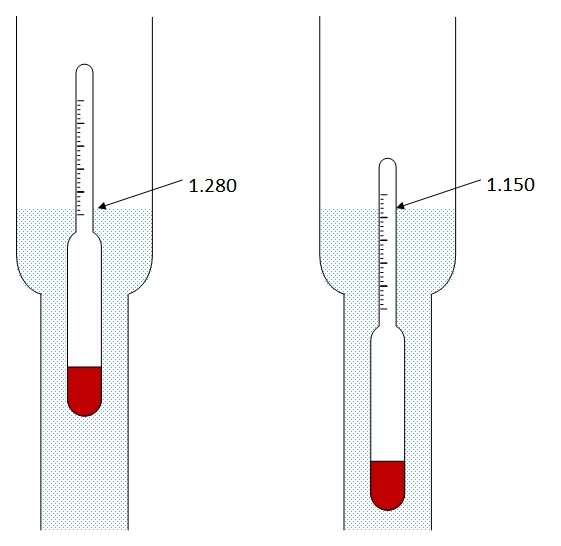
We use bulb hydrometers with plastic barrels. Glass barrel hydrometers are used in laboratory environments and are not suitable for field work where the glass barrel could be broken.
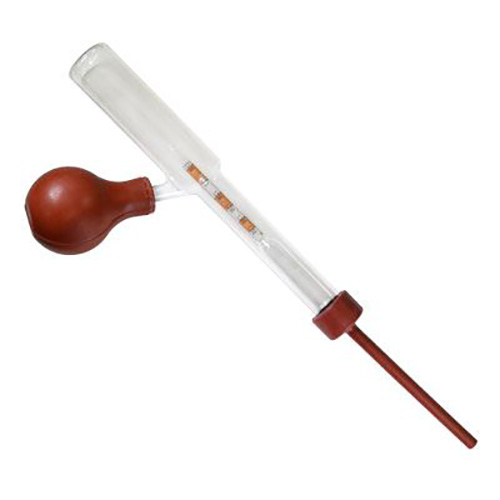
This is a float hydrometer without a bulb: the floating elements are plastic and they combine to make a hydrometer that is much easier to read than a traditional bulb hydrometer. In our experience this style of hydrometer needs a bit of practice to achieve consistent readings and it has a shorter life than a bulb hydrometer.
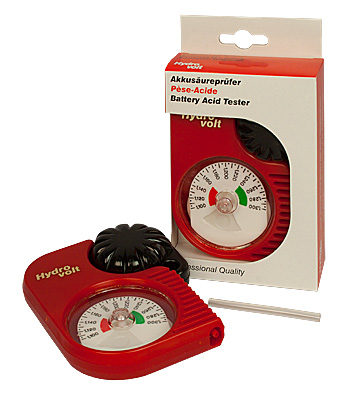
Image: Midnite Solar
A refractometer is a different kind of SG measurement device. Rather than floating a bulb in the acid, a single drop of acid is placed on the tool and the SG is measured based on the way light refracts through the liquid. The reading is made by pointing the tool at a light, looking through the lens, and reading the graduated scale visible there. Refractometers are the most accurate and easiest to but will be slower when measuring a large number of cells. Refractometers are available for many different applications and with different graduated scales; make sure you get one for measuring battery acid specific gravity.
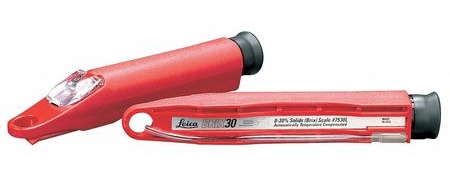
Specific gravity depends on the temperature of the acid. Depending on the type of hydrometer you have, you may need to apply correction factors for accuracy. Consult your device manual. Some have built-in thermometers for easy compensation and some have auto-compensation for temperature. That said, the temperature compensation factor applied for temperatures close to room temperature (20C to 30C) will be very small and, in many cases, can be ignored. If your batteries are very hot or cold then temperature compensation should be addressed. Here’s a table of specific gravity temperature compensation values. It assumes your hydrometer is calibrated at 25C. These are acid temperatures, not ambient temperatures.
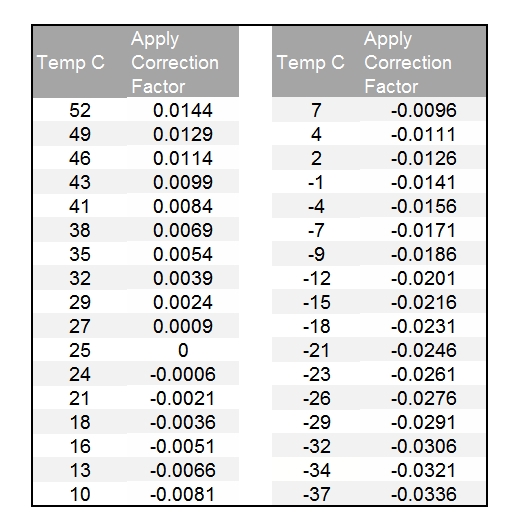
Remember that battery acid is dangerous! Any time you are working with acid you should wear protective gloves and a face shield and be sure to wear a rubber apron or disposable clothes. Synthetics are more resistant than natural fibers.
Tools should be thoroughly rinsed with distilled water after use, dried, and stored in a cool dry place.
Regardless of the type of hydrometer you choose, it’s important to learn how to use it, how to apply temperature compensation factors if needed, and what to do with the data it gives you. Keep your SG readings in a log book for reference; this can be valuable for troubleshooting down the road and is a requirement for making a warranty claim on a battery, should the need arise.
Related Posts
You may also like
- Diversity: Your Secret Weapon in Uncertain Times Read Article
- Reliability vs. Resiliency: Strategies for Backup Power Systems Read Article
- The dirt on the OHRS Program Read Article
- Solar Property Buy/Sell Cheat Sheet Read Article
- Preventative Maintenance for Off-Grid Applications: Essential! Read Article
